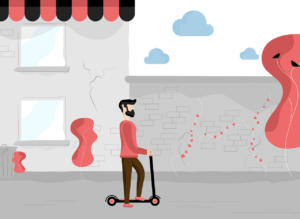
Picture this: you’re cruising down the street on your snazzy scooter, feeling the wind in your hair and the sun on your face. It’s a glorious day for an exhilarating ride, but before you hit the road, it’s crucial to ensure your scooter is in tip-top shape. In this article, we’ll walk you through a checklist of pre-ride safety checks to help keep you safe and secure throughout your scooter adventures. So, let’s buckle up, or rather, gear up, and make sure we’re all set for a smooth and trouble-free ride!

This image is property of images.unsplash.com.
Check out our product reviews!
Tire Check
Inspect tire pressure
Before hopping on your scooter and cruising down the road, it’s essential to inspect your tire pressure. Proper tire pressure is crucial for maintaining stability, control, and overall safety on the road. Check your scooter’s user manual or the manufacturer’s recommendations to determine the appropriate tire pressure.
To inspect the tire pressure accurately, you will need a reliable tire pressure gauge. Simply remove the valve cap from each tire and press the gauge onto the valve stem firmly. The gauge will display the tire pressure, and you should compare it to the recommended pressure stated in the manual. If the pressure is too low, inflate the tire using an air compressor or visit a local service station.
Check tire tread depth
Another crucial aspect of tire safety is proper tread depth. The tire tread provides traction and grip, especially when roads are wet or slippery. Inspecting the tire tread depth is simple and can be done using a penny or a tread depth gauge. Place the penny upside down into the grooves of the tire tread. If you can see the top of Lincoln’s head, it’s time to replace your tires.
It is important never to neglect tire maintenance, as worn-out or under-inflated tires increase the risk of accidents, reduced control, and skidding. Proper tire care will not only keep you safe but also prolong the life of your scooter’s tires.
Brake Check
Test front and rear brakes
Ensuring your scooter’s brakes are functioning properly is vital for your safety and the safety of others on the road. Take a moment to test both the front and rear brakes before starting your ride. Gently squeeze the brake levers while parked to ensure they engage smoothly and provide adequate stopping power. If you feel any resistance or unusual clicking noises, it may be an indication of an issue that needs attention from a professional mechanic.
Ensure brake pads are not worn out
Inspecting your brake pads regularly is essential to guarantee optimum braking performance. Over time, brake pads wear down and lose their ability to grip the rotor effectively, which compromises your ability to stop efficiently. Look through the caliper and check the thickness of the brake pads. If they appear thinner than 3 millimeters, it’s time to replace them.
Never underestimate the importance of working brakes. A well-maintained braking system is crucial for quickly stopping your scooter and avoiding potential accidents. Invest time in regularly checking your brakes and addressing any issues promptly for a safe and worry-free ride.

This image is property of images.unsplash.com.
Check out our product reviews!
Light Check
Check headlight and taillight
Proper lighting on your scooter is crucial for visibility, especially during the night or in adverse weather conditions. Start by turning on your scooter’s headlight and confirming it is working correctly. If you notice any flickering or dimness, replace the bulb as a priority.
Next, take a moment to check the taillight. Activate the taillight and assess its brightness. It is crucial to ensure that the taillight is functioning correctly, as it alerts vehicles behind you to your presence on the road. If any issues arise with the taillight, replace the bulb or seek professional assistance if needed.
Test turn signals and brake lights
In addition to the headlight and taillight, your scooter should have functioning turn signals and brake lights. Activate your scooter’s turn signals one by one and observe if they are blinking at an appropriate speed. If they are not blinking, it could indicate a problem with the bulb or the wiring. Make sure to replace any faulty bulbs or consult a professional for further assistance.
Similarly, check your scooter’s brake lights by pressing the brake lever or pedal. Ensure that the brake lights illuminate brightly and promptly when the brakes are engaged. Faulty brake lights can catch motorists off guard and increase the risk of collisions. Regularly inspecting and maintaining your lights will help you stay visible on the road and ensure a safer riding experience.
Electrical Check
Check battery connections
A well-functioning electrical system is crucial for powering your scooter’s components and ensuring a smooth ride. Start by inspecting the battery connections. Make sure they are clean, tight, and free from corrosion. Loose or corroded connections can lead to electrical issues and potentially cause your scooter to malfunction.
If you notice any corrosion, you can use a wire brush or sandpaper to clean the terminals. Apply a thin layer of dielectric grease or petroleum jelly to prevent future corrosion. Additionally, make sure the battery is securely fastened in its designated location, as loose batteries can cause electrical shorts or damage while riding.
Ensure all electrical systems are functioning
Apart from the battery connections, it is essential to verify that all electrical systems on your scooter are functioning correctly. Turn on the indicators, horn, and any other electrical components your scooter may have. If any of these systems are not working or producing weak signals, address the issue promptly.
Faulty electrical systems can lead to unexpected power loss or compromised safety features. Regularly checking and maintaining your scooter’s electrical systems will help identify any problems before they escalate, ensuring a safer and more enjoyable riding experience.

This image is property of images.unsplash.com.
Fuel Check
Check fuel level
Before setting off on your scooter adventure, it is crucial to verify the fuel level. Running out of fuel unexpectedly can leave you stranded on the side of the road, which can be inconvenient and dangerous, particularly in remote areas.
Most scooters have a fuel gauge to provide an accurate reading of the remaining fuel. Consult your scooter’s user manual to locate the gauge and familiarize yourself with its accuracy. If your scooter doesn’t have a fuel gauge, it is essential to develop a rough estimate of your scooter’s fuel consumption. Regularly monitoring your fuel level will help you plan your rides, ensuring you never run out of fuel.
Inspect fuel lines for leaks
Inspecting the fuel lines for leaks is crucial to avoid any hazardous situations while riding. Check the fuel lines for any signs of leakage, such as damp spots or a strong scent of gasoline around the connections. If you suspect a fuel leak, it is highly recommended to consult a professional technician to address the issue immediately.
Maintaining a proper fuel level and regularly inspecting for leaks will help prevent any unexpected breakdowns or accidents. By ensuring your scooter’s fuel system is in good condition, you can confidently embark on your rides with peace of mind.
Mirror Check
Ensure mirrors are properly adjusted
Mirrors are an essential safety feature on your scooter, providing you with a clear view of approaching traffic and your surroundings. Before embarking on your ride, take a moment to adjust your mirrors properly. Each mirror should provide a clear view of the road behind you and should not be obstructed by your arms or body.
To adjust the mirrors, sit on your scooter and use the controls or manually move the mirrors until you have a clear view. It is important to remember that mirrors need periodic readjustment, as they may shift due to vibrations or accidental knocks.
Check for any cracks or damage
A cracked or damaged mirror not only compromises your vision but also poses a safety risk. Inspect your mirrors for any cracks or signs of damage. Cracks can distort your view or potentially shatter while riding, endangering yourself and others.
If you notice any cracks or damage, replace the mirrors as soon as possible. Riding with clear and undamaged mirrors enhances your situational awareness, allowing you to react to any potential hazards on the road promptly.
Kickstand Check
Make sure kickstand is working properly
The kickstand is a small yet critical component of your scooter’s safety. Before starting your ride, ensure that the kickstand is working properly. Extend the kickstand and verify that it locks firmly in place. Gently apply pressure to test its stability and ensure that it can securely hold your scooter when parked.
If you encounter any issues with the kickstand, such as it not locking or wobbling, refrain from riding until the problem is addressed. Riding with a faulty kickstand can lead to your scooter toppling over unexpectedly, causing damage or injury. Promptly repair or replace the kickstand if necessary.
Ensure it securely holds the scooter when parked
In addition to confirming that the kickstand is working properly, it is also important to ensure that it securely holds the scooter when parked on various surfaces. Test the kickstand’s stability on flat ground and on slight inclines. If the scooter feels unstable or if the kickstand sinks into the ground, refrain from parking in that location to avoid potential accidents.
Reliable and functioning kickstands provide peace of mind and prevent accidental falls, protecting your scooter from damage and ensuring a safe riding experience.
Helmet Check
Inspect helmet for any cracks or damage
Wearing a helmet is one of the most crucial safety measures you can take while riding your scooter. Before you begin your ride, inspect your helmet for any cracks or signs of damage. Pay close attention to the shell, especially around areas that have experienced impact in the past.
Even minor cracks can compromise the overall strength and effectiveness of the helmet, reducing its ability to protect your head in case of an accident. If you notice any cracks, consider replacing your helmet immediately to ensure optimal protection.
Ensure straps are securely fastened
Along with inspecting the helmet itself, it is crucial to ensure that the straps are securely fastened. The chin strap should be snugly tightened to keep the helmet in place during your ride. A loose strap may lead to the helmet shifting or falling off in the event of an accident, significantly increasing the risk of head injuries.
Before embarking on your ride, double-check the chin strap and make sure it is properly fastened. Adjust the strap as necessary to achieve a secure and comfortable fit. Wearing a properly fitted helmet will significantly enhance your safety and minimize the risk of head injuries in case of a crash.
Clothing Check
Wear appropriate protective clothing
Choosing and wearing the right clothing is essential for your safety while riding a scooter. Opt for protective clothing that covers your exposed skin to minimize injuries in case of a fall or accident. Ideally, wear a sturdy, full-face helmet, a protective jacket, long pants, gloves, and boots that cover your ankles.
Protective jackets and pants should be made of abrasion-resistant materials, such as leather or reinforced textiles, to provide an additional layer of protection. Gloves and boots specifically designed for motorcycle riding offer enhanced grip and impact protection.
Remember that proper protective clothing not only shields you from potential injuries but also contributes to your overall comfort and confidence while riding.
Check for loose or dangling clothing
Before embarking on your scooter adventure, check your clothing for any loose or dangling items that may pose a safety risk. Loose clothing, such as scarves or long belts, can become entangled in the moving parts of your scooter, compromising your control and balance.
Securely tuck in loose ends, fasten zippers, and ensure that your clothing does not obstruct any controls or pedals. Always choose clothing that fits properly and is unlikely to get caught in any mechanisms while riding. By eliminating distractions and potential hazards, you can fully focus on the road and enjoy a safe ride.
Weather Check
Check weather forecast before riding
Checking the weather forecast is a simple yet crucial step in planning a safe scooter ride. Before you hop on your scooter, take a few minutes to check the weather conditions for your intended route and destination. Knowing what to expect in terms of rain, wind, or extreme temperatures will help you prepare adequately and adjust your riding plans accordingly.
If the forecast indicates inclement weather, consider postponing your ride if possible. Riding in challenging weather conditions, such as heavy rain, strong winds, or snow, significantly increases the risk of accidents and reduces visibility. Prioritize your safety and reschedule your ride for a day when the weather conditions are more favorable.
Adjust riding plans according to weather conditions
In situations where you decide to proceed with your ride despite less-than-ideal weather conditions, make adjustments to your riding plans accordingly. Reduce your speed, increase your following distance, and exercise extra caution on slippery or wet surfaces. Be aware that other road users may also be affected by the weather, so anticipate potential hazards and react accordingly.
Consider investing in appropriate rain gear, such as waterproof jackets and pants, to help you stay dry and comfortable during wet rides. Adequate preparation and adjusting your riding style to suit the weather conditions will significantly enhance your safety and ensure an enjoyable riding experience.
By following these pre-ride safety checks, you can confidently hop on your scooter and enjoy the freedom of the open road. Remember that thorough inspections and regular maintenance contribute to both your safety and the longevity of your scooter. Prioritize safety at all times, and happy riding!














